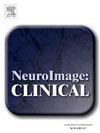帕金森病静息状态网络的纵向变化
IF 3.6
2区 医学
Q2 NEUROIMAGING
引用次数: 0
摘要
脑深部电刺激(DBS),以及电极植入和多巴胺能药物治疗,可以减轻帕金森病(PD)患者的症状。此外,三个选项对网络活动的影响是分别已知的。然而,长期影响很少被调查。因此,在本研究中,我们将重点关注多巴胺能药物对DBS电极植入后全脑网络活动的长期影响。因此,我们从脑磁图数据中提取了20例PD患者(4名女性,(59.00±9.72岁)的静息状态网络(RSNs)。我们记录了植入电极前两天和一年后30分钟的静息状态活动,有和没有多巴胺能药物,但DBS被关闭。基于低频相位和高伽马振幅之间的相幅耦合获得rsn,并检查不同条件(即术前与术后)之间的差异。我们在所有条件下确定了三个rsn:感觉-运动、视觉和额叶。在患者接受多巴胺能药物和DBS治疗的同时,每个RSN都选择性地改变了一年的疾病进展。与之前的文献一致,我们关注电极植入后rsn随时间的纵向变化,承认慢性DBS治疗和其他因素可能会混淆这些变化的解释。此外,所发现的改变是RSN特异性的,多巴胺能药物对额部RSN的影响更大,而疾病进展所表达的纵向因素在SMN和视觉RSN的改变中更为严重。本文章由计算机程序翻译,如有差异,请以英文原文为准。
Longitudinal changes of resting-state networks in Parkinson‘s disease
Deep brain stimulation (DBS), but also the sole implantation of the electrodes and dopaminergic medication, can reduce symptoms in Parkinson’s disease (PD) patients. Furthermore, an effect on network activity is known for all three options separately. However, long-term effects have rarely been investigated. Therefore, in the present study, we focus on the long-term impact of dopaminergic medication on whole-brain network activity following DBS electrode implantation.
Therefore, we extracted resting state networks (RSNs) of 20 PD patients (4 females, (59.00 ± 9.72 years) from magnetoencephalography data. We recorded 30 min of resting-state activity two days before and one year after implantation of the electrodes with and without dopaminergic medication, but DBS was turned off. RSNs were obtained based on the phase-amplitude coupling between a low-frequency phase and a high gamma amplitude and examined for differences between conditions (i.e., pre- vs. post-surgery).
We identified three RSNs across all conditions: sensory-motor, visual, and frontal. Each RSN was selectively altered due to a year of disease progression – while patients being treated with dopaminergic medication and DBS. In line with previous literature, we focus on longitudinal changes in RSNs over time after electrode implantation, acknowledging that chronic DBS treatment and other factors may confound the interpretation of these changes. In addition, the alterations found were RSN specific, as dopaminergic medication showed a greater impact on the frontal RSN, and the longitudinal factor expressed by the disease progression was more severe in alterations in the SMN and the visual RSN.
求助全文
通过发布文献求助,成功后即可免费获取论文全文。
去求助
来源期刊

Neuroimage-Clinical
NEUROIMAGING-
CiteScore
7.50
自引率
4.80%
发文量
368
审稿时长
52 days
期刊介绍:
NeuroImage: Clinical, a journal of diseases, disorders and syndromes involving the Nervous System, provides a vehicle for communicating important advances in the study of abnormal structure-function relationships of the human nervous system based on imaging.
The focus of NeuroImage: Clinical is on defining changes to the brain associated with primary neurologic and psychiatric diseases and disorders of the nervous system as well as behavioral syndromes and developmental conditions. The main criterion for judging papers is the extent of scientific advancement in the understanding of the pathophysiologic mechanisms of diseases and disorders, in identification of functional models that link clinical signs and symptoms with brain function and in the creation of image based tools applicable to a broad range of clinical needs including diagnosis, monitoring and tracking of illness, predicting therapeutic response and development of new treatments. Papers dealing with structure and function in animal models will also be considered if they reveal mechanisms that can be readily translated to human conditions.
 求助内容:
求助内容: 应助结果提醒方式:
应助结果提醒方式:


